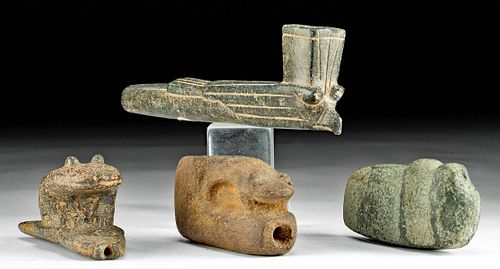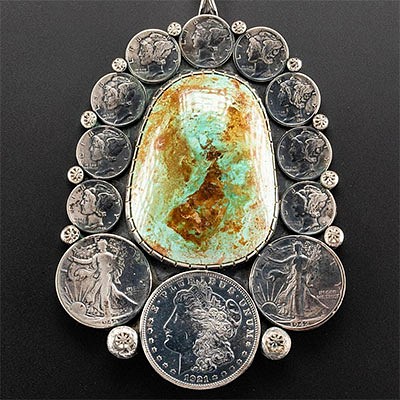3 Native American Woodlands Stone Pipes & 1 Axe Head
Lot 41a
About Seller
Artemis Fine Arts
686 S Taylor Ave, Ste 106
Louisville, CO 80027
United States
Selling antiquities, ancient and ethnographic art online since 1993, Artemis Gallery specializes in Classical Antiquities (Egyptian, Greek, Roman, Near Eastern), Asian, Pre-Columbian, African / Tribal / Oceanographic art. Our extensive inventory includes pottery, stone, metal, wood, glass and textil...Read more
Categories
Estimate:
$2,500 - $3,500
Absentee vs Live bid
Two ways to bid:
- Leave a max absentee bid and the platform will bid on your behalf up to your maximum bid during the live auction.
- Bid live during the auction and your bids will be submitted real-time to the auctioneer.
Bid Increments
| Price | Bid Increment |
|---|---|
| $0 | $25 |
| $300 | $50 |
| $1,000 | $100 |
| $2,000 | $250 |
| $5,000 | $500 |
| $10,000 | $1,000 |
| $20,000 | $2,500 |
| $50,000 | $5,000 |
| $100,000 | $10,000 |
| $200,000 | $20,000 |
About Auction
By Artemis Fine Arts
Feb 25, 2021
Set Reminder
2021-02-25 10:00:00
2021-02-25 10:00:00
America/New_York
Bidsquare
Bidsquare : American Frontier | Ethnographic | Tribal Art
https://www.bidsquare.com/auctions/artemis-gallery/american-frontier-ethnographic-tribal-art-6449
Featuring historical examples from the American, Spanish, and Mexican frontiers, as well as Native American, Ethnographic, Tribal, Oceanic, Spanish Colonial, more. All items offered for sale have been legally acquired, are legal to sell and are guaranteed to be as described or your money back. Artemis Fine Arts info@artemisfinearts.com
Featuring historical examples from the American, Spanish, and Mexican frontiers, as well as Native American, Ethnographic, Tribal, Oceanic, Spanish Colonial, more. All items offered for sale have been legally acquired, are legal to sell and are guaranteed to be as described or your money back. Artemis Fine Arts info@artemisfinearts.com
- Lot Description
North America, east-central Tennessee (Overton County), Middle Woodland period, ca. 200 to 1000 CE. A fabulous set of four hand-carved stone pieces; three zoomorphic pipes, and one axe head. Enveloped in mottled hues of dark and light grey, the largest pipe has been smoothly carved into the form of an eagle or falcon with its tail displayed at the top of the pipe and its wings folded at its side. The pipe itself features an elongated form with a circular rim, a cylindrical body, and a cuboid fill hole that extends upwards from the end of the vessel. Below the fill hole, the avian creature's head exhibits bulging eyes and a sizable curved beak. The second pipe is in the form of a frog seated on a fish in a natural shade of light grey. With an annular aperture carved into his back to act as a fill hole, the frog showcases a flat snout with incised nostrils, a straight mouth, and round eyes that rise from his head. The fish boasts a flat form carefully incised with scales, fins, an annular eye, and an open mouth that operates as a blow hole. Please note that the Lucite stand is for photography purposes only. Size of largest: 8.125" L x 1.125" W x 2.25" H (20.6 cm x 2.9 cm x 5.7 cm)
Covered in a warm hue of sienna, the third pipe shows a small animal standing atop its lengthy body, as well as an annular blow hole and a raised fill hole. The last object is the axe head, which presents in a hue of light bluish-grey with a rectangular body that tapers to a sharp edge and a corseted area where it was once tied to its handle.
These types of pipes are a rare effigy form, which often featured animal figures, birds being the most common. Scholars posit that smoking pipes played an important role in Eastern Woodland culture, which spanned from sub-Arctic Canada to the southern United States. The earliest evidence we have for the use of tobacco in this area comes from ca. 100 to 200 CE; in addition to tobacco, and often prior to it, we know from ethnohistorical accounts that people smoked a variety of other plants, including dogwood, juniper, sumac, and bearberry. These pipes were not just made for the simple act of smoking; they seem to have had a strong religious component as well, and various archaeological sites from the period, including the Hopewell Mound sites, have the remains of hundreds of destroyed platform pipes, including effigy ones like these. Others were buried with their owners individually. Effigy platform pipes are believed to be totemic animals or spirits from Native cosmology.
Provenance: ex-private Ventura County, California, USA collection, acquired prior to 2008
All items legal to buy/sell under U.S. Statute covering cultural patrimony Code 2600, CHAPTER 14, and are guaranteed to be as described or your money back.
A Certificate of Authenticity will accompany all winning bids.
We ship worldwide and handle all shipping in-house for your convenience.
#154054Collection label on bottom and chip to rim of largest. Expected surface wear with nicks/chips and abrasions as shown, all commensurate with age. Otherwise, intact and excellent with lovely earthen deposits throughout.Condition
- Shipping Info
-
All shipping is handled in-house for your convenience. Your invoice from Artemis Gallery will include shipping calculation instructions. If in doubt, please inquire BEFORE bidding for estimated shipping costs for individual items.
-
- Buyer's Premium



 EUR
EUR CAD
CAD AUD
AUD GBP
GBP MXN
MXN HKD
HKD CNY
CNY MYR
MYR SEK
SEK SGD
SGD CHF
CHF THB
THB
















